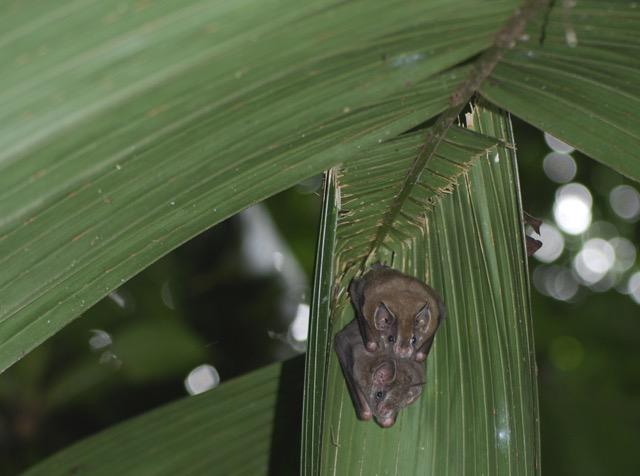Maripaula Valdés Bérriz
This project aims to determine the effect of dispersal to bat tents on seed and seedling survival of the large-seeded tree Brosimum alicastrum, in comparison to parental trees and other bat dispersal sites.

Two Artibeus watsoni in a bifid tent roost built on a Geonoma palm.
Only 2% of all bat species in the world occupy modified leaves as roosts, and 17 of these species are found in the neotropics. Most of them are obligate tent roosters that modify large leaves of 77 different species of plants, commonly from the families Arecaceae and Araceae. Large seeds have been considered to be dispersed mainly by medium to large vertebrates. However, it has been documented that small tent-roosting bats disperse a variety of large seeds to their tents in both primary forests and forest patches. Although they disperse a variety of large-seeded species, most of them are dispersed in low densities in comparison to the high seed and seedling density underneath parental trees and other feeding roosts. The distance to fruiting trees may also be larger for tent roosts than other feeding roosts. Therefore, dispersal to tents may provide an advantage over non-dispersal underneath parental trees and dispersal to other feeding roosts.
Small bats, such as tent-roosting bats, may play a crucial role as dispersers of large seeds when larger dispersal agents have disappeared. To be able to assess the demographic impact that dispersal by small tent-roosting bats may have on large-seeded trees, we need to identify the effect of dispersal to tents on seed and seedling survival. The tropical tree Brosimum alicastrum is used as a model species of large-seeded shade-tolerant trees that are typical of mature forests. The species is also important commercially, culturally, and as a source of food throughout its distribution. The aim of this project of the quantify seed and seedling survival underneath tents and compare it to that of parental trees and other feeding roosts. Seedling survival will be monitored during the first 10 months after germination, which covers the period of highest mortality for seedlings of large-seeded trees.
Since dispersal of large seeds is limited in disturbed sites, this research will allow us to determine which roosts will not only promote dispersal, but also increase seed and seedling survival. This information can be taken into account when deciding which plant species should be introduced to enhance regeneration processes in deforested sites, forests fragments and managed forests. Reestablishing ecological processes may be a more realistic goal for restoration efforts to that increase vegetation complexity, and to achieve this goal, we need to identify which agents most efficiently enhance them.